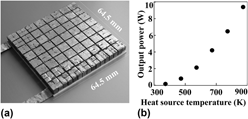Crossref Citations
This article has been cited by the following publications. This list is generated based on data provided by
Crossref.
Baran, Jakub D.
Kepaptsoglou, Demie
Molinari, Marco
Kulwongwit, Nuth
Azough, Feridoon
Freer, Robert
Ramasse, Quentin M.
and
Parker, Stephen C.
2016.
Role of Structure and Defect Chemistry in High-Performance Thermoelectric Bismuth Strontium Cobalt Oxides.
Chemistry of Materials,
Vol. 28,
Issue. 20,
p.
7470.
Ramasse, Quentin M.
Kepaptsoglou, Demie M.
Baran, Jakub D.
Molinari, Marco
Parker, Stephen C.
Mizoguchi, Teruyasu
Azough, Feridoon
and
Freer, Robert
2017.
Atomic-scale characterization of thermoelectric oxides using high spatial and energy resolution STEM-EELS.
Microscopy and Microanalysis,
Vol. 23,
Issue. S1,
p.
370.
Diez, Juan-Carlos
Rasekh, Shahed
Madre, Maria A.
Torres, Miguel A.
and
Sotelo, Andres E.
2018.
High thermoelectric performances of Bi–AE–Co–O compounds directionally growth from the melt.
Boletín de la Sociedad Española de Cerámica y Vidrio,
Vol. 57,
Issue. 1,
p.
1.
Bai, Yang
Jantunen, Heli
and
Juuti, Jari
2018.
Energy Harvesting Research: The Road from Single Source to Multisource.
Advanced Materials,
Vol. 30,
Issue. 34,
Nirmal Kumar, V.
Hayakawa, Y.
Udono, H.
and
Inatomi, Y.
2019.
Enhanced thermoelectric properties of InSb: Studies on In/Ga doped GaSb/InSb crystals.
Intermetallics,
Vol. 105,
Issue. ,
p.
21.
Gainza, J.
Serrano-Sánchez, F.
Gharsallah, M.
Carrascoso, F.
Bermúdez, J.
Dura, O. J.
Mompean, F. J.
Biskup, N.
Meléndez, J. J.
Martínez, J. L.
Alonso, J. A.
and
Nemes, N. M.
2019.
Evidence of nanostructuring and reduced thermal conductivity in n-type Sb-alloyed SnSe thermoelectric polycrystals.
Journal of Applied Physics,
Vol. 126,
Issue. 4,
Bernik, Slavko
2021.
Thermoelectric Energy Conversion.
p.
269.
Ikeuchi, Satoaki
2021.
Thermoelectric Energy Conversion.
p.
539.
Sulaiman, Suraya
Sudin, Izman
Al-Naib, Uday M. Basheer
and
Omar, Muhammad Firdaus
2022.
Review of the Nanostructuring and Doping Strategies for High-Performance ZnO Thermoelectric Materials.
Crystals,
Vol. 12,
Issue. 8,
p.
1076.
Jung, Yong-Jae
Kim, Hyun-Sik
Won, Jong Ho
Kim, Minkyung
Kang, Minji
Jang, Eun Young
Binh, Nguyen Vu
Kim, Sang-il
Moon, Kyoung-Seok
Roh, Jong Wook
Nam, Woo Hyun
Koo, Sang-Mo
Oh, Jong-Min
Cho, Jung Young
and
Shin, Weon Ho
2022.
Thermoelectric Properties of Cu2Te Nanoparticle Incorporated N-Type Bi2Te2.7Se0.3.
Materials,
Vol. 15,
Issue. 6,
p.
2284.
Ochieng, Alfred Oloo
Megahed, Tamer F.
Ookawara, Shinichi
and
Hassan, Hamdy
2022.
Comprehensive review in waste heat recovery in different thermal energy-consuming processes using thermoelectric generators for electrical power generation.
Process Safety and Environmental Protection,
Vol. 162,
Issue. ,
p.
134.
Sulaiman, Suraya
Zamri, Nur Syazwa
Aziz, Radhiyah Abd
Sharif, Mohamad Farid Mohamad
Nawawi, Natasha Ahmad
and
Jamal, Nur Ayuni
2023.
Technological Advancement in Mechanical and Automotive Engineering.
p.
181.
Maor, Itzhak I.
Kruppa, Katharina
Rozencweig, Adi
Sterzer, Amir
Steinbach, Frank
Beilin, Vadim
Breidenstein, Bernd
Shter, Gennady E.
Mann‐Lahav, Meirav
Feldhoff, Armin
and
Grader, Gideon S.
2023.
Superior Thermoelectric Performance of Textured Ca3Co4−xO9+δ Ceramic Nanoribbons.
Advanced Functional Materials,
Vol. 33,
Issue. 49,
Maksymuk, Mykola
Zazakowny, Karolina
Lis, Adrianna
Kosonowski, Artur
Parashchuk, Taras
and
Wojciechowski, Krzysztof T.
2023.
Development of the anodized aluminum substrates for thermoelectric energy converters.
Ceramics International,
Vol. 49,
Issue. 3,
p.
4816.
Bresch, Sophie
Stargardt, Patrick
Moos, Ralf
and
Mieller, Björn
2024.
Co‐Fired Multilayer Thermoelectric Generators Based on Textured Calcium Cobaltite.
Advanced Electronic Materials,
Vol. 10,
Issue. 3,
Lee, Changwoo
Kim, Junsu
Heo, Minsu
Kim, Sang-il
and
Kim, Hyun-Sik
2024.
Thermoelectric Properties of In and Cr Co-Doped BiSbTe3.
Korean Journal of Materials Research,
Vol. 34,
Issue. 9,
p.
448.
Dong, Xuyang
Li, Huihui
Liu, Yiyuan
Li, Chenglong
Jia, Zhitai
Tao, Xutang
and
Mu, Wenxiang
2024.
Investigation on High-Temperature Thermoelectric Characteristics of β-Ga2O3.
ACS Applied Electronic Materials,
Vol. 6,
Issue. 12,
p.
9082.
Paulus, Daniel
Bresch, Sophie
Moos, Ralf
and
Schönauer-Kamin, Daniela
2024.
Powder aerosol deposited calcium cobaltite as textured P-type thermoelectric material with power factors approaching single crystal values.
Journal of the European Ceramic Society,
Vol. 44,
Issue. 15,
p.
116717.
Yusuf, Ibrahim D.
Suleiman, Abdussalam Balarabe
Lawal, Abdullahi
Ndikilar, Chifu E.
Taura, L.S.
Gidado, A.S.
and
Chiromawa, Idris Muhammad
2024.
Significant improvement in structural, electronic, optical and thermoelectric properties of PdTe2 in bulk and monolayer phase: A G0W0+BSE approach.
Physica B: Condensed Matter,
Vol. 685,
Issue. ,
p.
416015.
Kruppa, Katharina
Maor, Itzhak I.
Steinbach, Frank
Stobitzer, Dorothea
Shter, Gennady E.
Mann‐Lahav, Meirav
Grader, Gideon S.
and
Feldhoff, Armin
2025.
Asymmetric structuring of ceramic composite via co‐electrospun sodium cobaltite and calcium cobaltite nanoribbons.
Journal of the American Ceramic Society,
Vol. 108,
Issue. 5,



